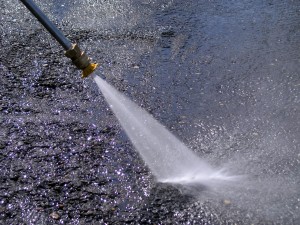A Billy Goat pressure washer can get the toughest dirt and stains off of sidewalks and driveways to make them look brand new, and it can also get the surface clean enough to ensure sealants can bond properly to protect your pavement through the winter. These tips will take you through the entire process to help you get the best results when cleaning concrete while minimizing damage to your home, your pressure washer, and the environment.
Preparing to Pressure Wash: Detergent, Waste Collection, and Sealant
Only use detergents designed specifically for pressure washers: muriatic acid may be popular for manually cleaning concrete, but this corrosive substance will eat through the seals and metals used to construct your equipment. Detergents designed for degreasing work best since they can remove oil stains that can’t be lifted by the water spray, but these can damage asphalt since it’s made from oil. Check the label to make sure it’s compatible with the surface you need to clean.
Depending on your local laws, you may need to take some extra steps to ensure you’re disposing of liquid waste properly. In most areas, it’s fine to use a biodegradable detergent and let it run off into storm drains, while other areas require that all waste be collected or diverted from storm drains to keep them from entering waterways. For small scale cleaning, you may only need to use a cover or berm on the closest storm drain.
There’s no better time to seal the surface of cement than after everything has been cleaned. The surface needs to be dry before application, so if you plan on doing everything in one day, make sure the pavement is pressure washed early morning and any standing water is wiped off with a squeegee to allow maximum evaporation.
Protecting Walls, Windows, and Doors
Plastic sheeting such as a drop cloth or moisture barrier should be hung over windows, doors and adjacent walls using painter’s tape to protect them from debris and accidental contact with the pressure washer’s spray.
Sweep off the Area to Be Cleaned
Leaves, grass clippings, and other loose debris should be swept off first to reduce the waste removed and the time required for pressure washing.
Spraying for Mechanical Removal of Dirt
If the surface is heavily soiled, start by removing the dirt physically through the use of the washer’s high-pressure spray. For the best results, use a 25-degree tip and keep the end of the wand 6-8 inches away from the pavement surface. For stubborn areas such as dried paint, the tip can be used 3-4 inches from the surface. Spraying directly at cracks may cause them to expand: start spraying away from the crack before moving the want over the area. Wait until the detergent has been applied before tackling stains from grease and oil.
Applying the Detergent
Switch to the soap nozzle and use the detergent hose to draw from a container filled with the concrete detergent. With the tip 6-8 inches from the surface, give the area an even coating of soap. Most detergents have a recommended dwell time to let the detergent work on the surface, typically around 5 minutes. Once this time has passed, the pavement can be rinsed.
Rinsing
Now that the oil has bonded to the detergent, it should lift off easily with a spray from the pressure washer. Like the initial cleaning, it’s best to use a 25-degree nozzle 6-8 inches from the surface.
Sealing
Now that the surface is clean, it’s simply a matter of waiting for the surface to dry before applying a sealant. Trying to seal the pavement while it’s still damp will keep the sealant from bonding, resulting in light colored streaking.
Getting Parts for Your Billy Goat Pressure Washer
Billygoatparts.com isn’t just a certified Billy Goat dealer, we’re also a dealer for the pump and engine manufacturers Billy Goat partners with to build their pressure washers. We stock OEM parts for your equipment, and we even have factory parts diagrams and descriptions built into our site to make it easy to find the parts you need. We can even ship your order to any location in the U.S. or Canada.

